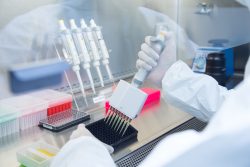 According to a new study by researchers at Stanford University of Medicine, old human cells will return to a more vigorous and youthful state following being induced to briefly express a protein panel involved in embryonic development. They team also discovered that elderly mice regained their youthful strength after their existing muscle stem cells were subjected to the protein treatment rejuvenation and then transplanted back into their bodies.
According to a new study by researchers at Stanford University of Medicine, old human cells will return to a more vigorous and youthful state following being induced to briefly express a protein panel involved in embryonic development. They team also discovered that elderly mice regained their youthful strength after their existing muscle stem cells were subjected to the protein treatment rejuvenation and then transplanted back into their bodies.
The proteins which are known as Yamanaka factors are typically used to transform adults cells into induced pluripotent stem cells or iPS cells. These iPS cells can become nearly any type of cell within the body regardless of the cell from which they originated. They have become important in regenerative medicine and drug discoveries.
The current study found that inducing old human cells in a lab dish for a brief period to express these proteins rewinds many of the molecular hallmarks of aging. They render the treated cells nearly indistinguishable from their younger counterparts.
When adult cells make iPS cells they become pluripotent and youthful. The team wondered if it might be possible to just rewind the aging clock without inducing pluripotency. They found that by tightly controlling the duration of the exposure to these protein factors, they were able to promote rejuvenation in multiple types of human cells.
The researchers make iPS cells from adult cells such as those that compose skin through repeatedly exposing them over a two week period to a panel of proteins which are vital to early embryonic development. They do so by introducing daily short lived RNA messages into the adult cells. The RNA messages then encode the instructions for making the Yamanaka proteins. These proteins over time rewind the fate of the cell by pushing them backward along the timeline of development until they resemble young, embryonic like pluripotent cells from which they originated.
During the process the cells shed any memories of their previous identities and they revert to a younger state. They accomplish this by wiping their DNA clean of the molecular tags that not only differentiate for example a skin cell from a heart muscle cell, but of other tags that accumulate as cell age.
The team wondered if old human cells would respond similarly and whether the response would be limited to a few cell types or generalizable for many tissues. They created a way to use genetic material called messenger RNA to temporarily express six reprogramming factors which were the four Yamanaka factors plus two additional proteins found in blood vessel cells and human skin. Messenger RNA will rapidly degrade in cells which allowed the researchers to tightly control the duration of the signal.
The team then compared the gene expression pattern of the treated cells and control cells which were both obtained from older adults, with those of untreated cells from younger people. They discovered that cells from the older adults exhibited signs of aging reversal following four days of exposure to the reprogramming factors. However the untreated older cells expressed higher levels of genes associated with known aging pathways. Treated older cells more closely resembled younger cells in their patterns of gene expression.
When they studied the patterns of aging associated chemical tags which are known as methyl groups which serve as indicators of a cell’s chronological age, they discovered that the treated cells appeared to be approximately 1-1/2 to 3-1/2 younger on average than the untreated cells from the older people. They showed peaks of 3-1/2 years (in skin cells) and 7-1/2 years in cells that line blood vessels.
The researchers then compared several hallmarks of aging including how cells metabolize compounds to create energy and dispose of cellular trash and how cells sense nutrients, among cells from young people, treated cells from older adults and untreated cells fro older adults.
They saw a dramatic rejuvenation across all the hallmarks but one in all the types of cells that were tested. The last and most experiment was done stem cells found in the muscles. Although these cell types are naturally endowed with the ability to self renew, this ability wanes with aging. The team wondered if they could also rejuvenate these stem cells and have a long term effect?
When they transplanted elderly mouse muscle stem cells that had been treated back into elderly mice, the mice regained the muscle strength similar to younger mice.
The team then isolated cells from the cartilage of people without and with osteoarthritis. They discovered that the temporary exposure of the osteoarthritic cells to the reprogramming factors reduced the secretion of inflammatory molecules and also improved the ability of the cells to divide and function.
The team is now optimizing the panel of reprogramming proteins needed to rejuvenate human cells. They are also looking at the possibility of treating tissues or cells without removing them from the body.
To view the original scientific study click below





